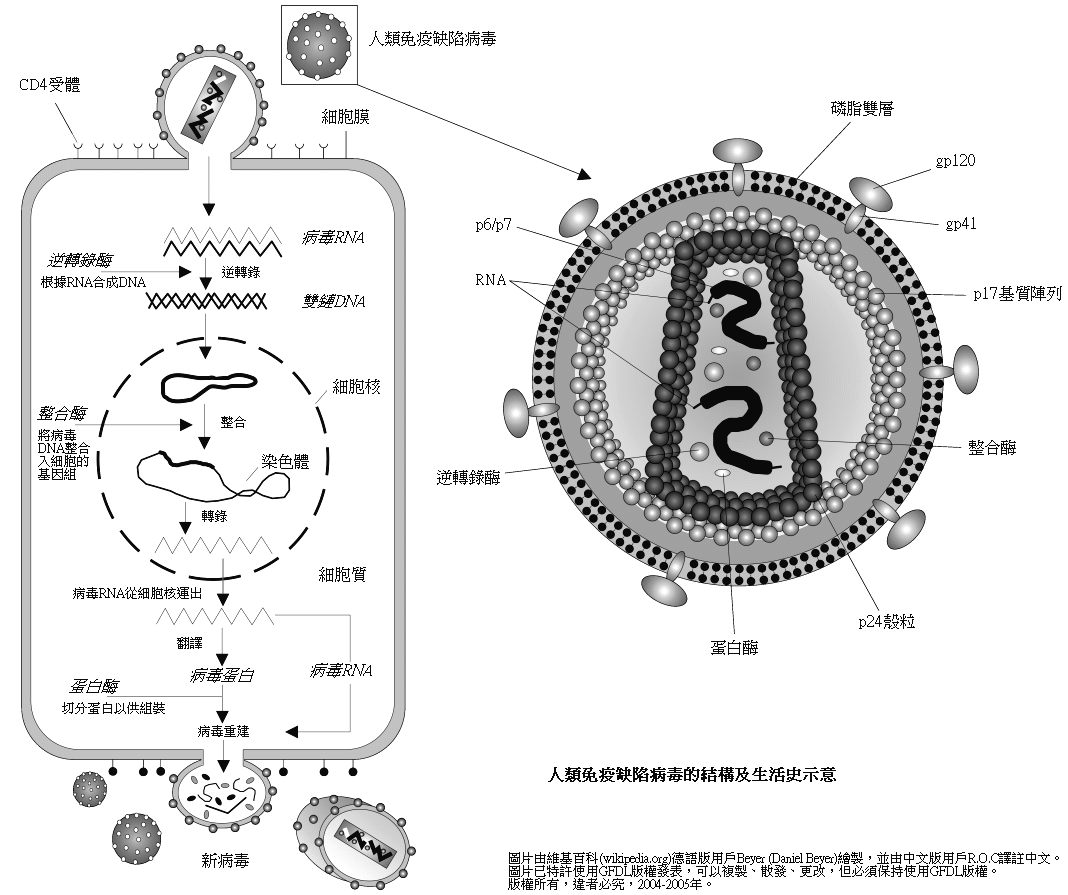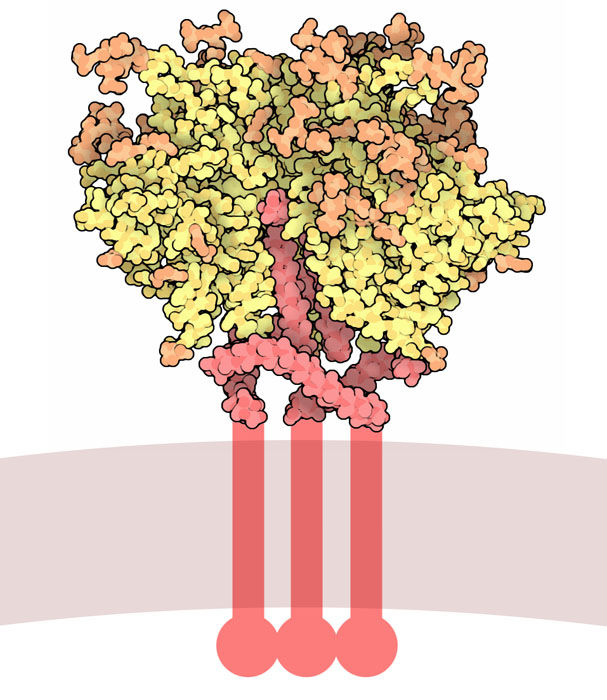|
SAV001
SAV001-H is the first candidate preventive HIV vaccine using a killed or "dead" version of the HIV-1 virus. The vaccine was developed by Dr. Chil-Yong Kang and his research team at Western University’s Schulich School of Medicine & Dentistry in Canada. The results of the Phase I clinical trial, completed in August 2013, showed no serious adverse effects in 33 participants. Vaccine design The SAV001-H vaccine is considered to be the first whole killed genetically modified HIV-1 vaccine. According to Dr. Kang, the HIV-1 strain was genetically engineered such that first, “the gene responsible for pathogenicity, known as ''nef''” is removed to make it non-pathogenic. Then, the signal peptide gene is replaced with a honey bee toxin (melittin) signal peptide to make the virus production much higher and faster. In the signal peptide exchange process, another gene called ''vpu'' is lost due to an overlapping. Finally, this genetically modified version of HIV-1, (i.e., HIV-1 virus ... [...More Info...] [...Related Items...] OR: [Wikipedia] [Google] [Baidu] |
University Of Western Ontario
The University of Western Ontario (UWO), also known as Western University or Western, is a Public university, public research university in London, Ontario, London, Ontario, Canada. The main campus is located on of land, surrounded by residential neighbourhoods and the Thames River (Ontario), Thames River bisecting the campus's eastern portion. The university operates twelve academic faculties and schools. It is a member of the U15 Group of Canadian Research Universities, U15, a group of research-intensive universities in Canada. The university was founded on 7 March 1878 by Bishop Isaac Hellmuth of the Diocese of Huron, Anglican Diocese of Huron as the Western University of London, Ontario. It incorporated Huron University College, Huron College, which had been founded in 1863. The first four faculties were Arts, Divinity, Law and Medicine. The university became non-denominational in 1908. Beginning in 1919, the university had affiliated with several denominational colleges. T ... [...More Info...] [...Related Items...] OR: [Wikipedia] [Google] [Baidu] |
HIV Vaccine
An HIV vaccine is a potential vaccine that could be either a preventive vaccine or a therapeutic vaccine, which means it would either protect individuals from being infected with HIV or treat HIV-infected individuals. It is thought that an HIV vaccine could either induce an immune response against HIV (active vaccination approach) or consist of preformed antibodies against HIV (passive vaccination approach). Two active vaccine regimens, studied in the RV 144 and Imbokodo trials, showed they can prevent HIV in some individuals. However, the protection was in relatively few individuals, and was not long lasting. For these reasons, no HIV vaccines have been licensed for the market yet. Difficulties in development In 1984, after it was confirmed that HIV caused AIDS, the United States Health and Human Services Secretary Margaret Heckler declared that a vaccine would be available within two years. However, priming the adaptive immune system to recognize the viral envelope protein ... [...More Info...] [...Related Items...] OR: [Wikipedia] [Google] [Baidu] |
Cytotoxic T-lymphocyte
A cytotoxic T cell (also known as TC, cytotoxic T lymphocyte, CTL, T-killer cell, cytolytic T cell, CD8+ T-cell or killer T cell) is a T lymphocyte (a type of white blood cell) that kills cancer cells, cells that are infected by intracellular pathogens (such as viruses or bacteria), or cells that are damaged in other ways. Most cytotoxic T cells express T-cell receptors (TCRs) that can recognize a specific antigen. An antigen is a molecule capable of stimulating an immune response and is often produced by cancer cells, viruses, bacteria or intracellular signals. Antigens inside a cell are bound to class I MHC molecules, and brought to the surface of the cell by the class I MHC molecule, where they can be recognized by the T cell. If the TCR is specific for that antigen, it binds to the complex of the class I MHC molecule and the antigen, and the T cell destroys the cell. In order for the TCR to bind to the class I MHC molecule, the former must be accompanied by a glycoprotein ca ... [...More Info...] [...Related Items...] OR: [Wikipedia] [Google] [Baidu] |
Hepatitis B
Hepatitis B is an infectious disease caused by the ''Hepatitis B virus'' (HBV) that affects the liver; it is a type of viral hepatitis. It can cause both acute and chronic infection. Many people have no symptoms during an initial infection. For others, symptoms may appear 30 to 180 days after becoming infected and can include a rapid onset of sickness with nausea, vomiting, yellowish skin, fatigue, dark urine, and abdominal pain. Symptoms during acute infection typically last for a few weeks, though some people may feel sick for up to six months. Deaths resulting from acute stage HBV infections are rare. An HBV infection lasting longer than six months is usually considered chronic. The likelihood of developing chronic hepatitis B is higher for those who are infected with HBV at a younger age. About 90% of those infected during or shortly after birth develop chronic hepatitis B, while less than 10% of those infected after the age of five develop chronic cases. Most of those wit ... [...More Info...] [...Related Items...] OR: [Wikipedia] [Google] [Baidu] |
Remune
Remune is the first therapeutic HIV vaccine based on the killed whole virus approach. Remune was initially invented by Jonas Salk in 1987 and is now being developed by Immune Response BioPharma, Inc. (IRBP) Remune is a therapeutic HIV/AIDS vaccine that has completed over 25 clinical studies to date and shows a robust mechanism of action restoring white blood cell counts in CD4 & CD8 T cells by reducing viral load and increasing immunity. The FDA is currently reviewing IRBP’s BLA (biologics licensing application) for therapeutic treatment in people with HIV. Once the FDA approves the BLA, Remune will be the first therapeutic HIV vaccine brought to market. IRBP is set to submit its BLA with the FDA in early 2014. REMUNE granted FDA Pediatric Orphan Designation on Feb 14th 2014. Vaccine Design Remune is made of beta-propiolactone inactive HIV-1 which has been irradiated to destroy the viral genome. The vaccine, however, does not contain gp120 surface antigen as it falls off ... [...More Info...] [...Related Items...] OR: [Wikipedia] [Google] [Baidu] |
Jonas Salk
Jonas Edward Salk (; born Jonas Salk; October 28, 1914June 23, 1995) was an American virologist and medical researcher who developed one of the first successful polio vaccines. He was born in New York City and attended the City College of New York and New York University School of Medicine. In 1947, Salk accepted a professorship in the School of Medicine at the University of Pittsburgh. It was there that he undertook a project to determine the number of different types of poliovirus, starting in 1948. For the next seven years, Salk devoted himself towards developing a vaccine against polio. Salk was immediately hailed as a "miracle worker" when the vaccine's success was first made public in April 1955, and chose to not patent the vaccine or seek any profit from it in order to maximize its global distribution. The National Foundation for Infantile Paralysis and the University of Pittsburgh looked into patenting the vaccine but, since Salk's techniques were not novel, their paten ... [...More Info...] [...Related Items...] OR: [Wikipedia] [Google] [Baidu] |
Simian Immunodeficiency Virus
''Simian immunodeficiency virus'' (''SIV'') is a species of retrovirus that cause persistent infections in at least 45 species of non-human primates. Based on analysis of strains found in four species of monkeys from Bioko Island, which was isolated from the mainland by rising sea levels about 11,000 years ago, it has been concluded that SIV has been present in monkeys and apes for at least 32,000 years, and probably much longer. Virus strains from three of these primate species, SIVsmm in sooty mangabeys, SIVgor in gorillas and SIVcpz in chimpanzees, are believed to have crossed the species barrier into humans, resulting in HIV-2 and HIV-1 respectively, the two HIV viruses. The most likely route of transmission of HIV-1 to humans involves contact with the blood of chimps and gorillas that are often hunted for bushmeat in Africa. Four subtypes of HIV-1 (M, N, O, and P) likely arose through four separate transmissions of SIV to humans, and the resulting HIV-1 group M strain most ... [...More Info...] [...Related Items...] OR: [Wikipedia] [Google] [Baidu] |
CD8+ T Cells
A cytotoxic T cell (also known as TC, cytotoxic T lymphocyte, CTL, T-killer cell, cytolytic T cell, CD8+ T-cell or killer T cell) is a T lymphocyte (a type of white blood cell) that kills cancer cells, cells that are infected by intracellular pathogens (such as viruses or bacteria), or cells that are damaged in other ways. Most cytotoxic T cells express T-cell receptors (TCRs) that can recognize a specific antigen. An antigen is a molecule capable of stimulating an immune response and is often produced by cancer cells, viruses, bacteria or intracellular signals. Antigens inside a cell are bound to class I MHC molecules, and brought to the surface of the cell by the class I MHC molecule, where they can be recognized by the T cell. If the TCR is specific for that antigen, it binds to the complex of the class I MHC molecule and the antigen, and the T cell destroys the cell. In order for the TCR to bind to the class I MHC molecule, the former must be accompanied by a glycoprotein ... [...More Info...] [...Related Items...] OR: [Wikipedia] [Google] [Baidu] |
Gp120
Envelope glycoprotein GP120 (or gp120) is a glycoprotein exposed on the surface of the HIV envelope. It was discovered by Professors Tun-Hou Lee and Myron "Max" Essex of the Harvard School of Public Health in 1988. The 120 in its name comes from its molecular weight of 120 kDa. Gp120 is essential for virus entry into cells as it plays a vital role in attachment to specific cell surface receptors. These receptors are DC-SIGN, Heparan Sulfate Proteoglycan and a specific interaction with the CD4 receptor, particularly on helper T-cells. Binding to CD4 induces the start of a cascade of conformational changes in gp120 and gp41 that lead to the fusion of the viral membrane with the host cell membrane. Binding to CD4 is mainly electrostatic although there are van der Waals interactions and hydrogen bonds. Gp120 is coded by the HIV ''env'' gene, which is around 2.5 kb long and codes for around 850 amino acids.Kuiken, C., Leitner, T., Foley, B., ''et al.'' (2008)"HIV Sequence Compe ... [...More Info...] [...Related Items...] OR: [Wikipedia] [Google] [Baidu] |
HIV-1
The subtypes of HIV include two major types, HIV type 1 (HIV-1) and HIV type 2 (HIV-2). HIV-1 is related to viruses found in chimpanzees and gorillas living in western Africa, while HIV-2 viruses are related to viruses found in the sooty mangabey, a vulnerable West African primate. HIV-1 viruses can be further divided into groups M, N, O and P. The HIV-1 group M viruses predominate and are responsible for the AIDS pandemic. Group M can be further subdivided into subtypes based on genetic sequence data. Some of the subtypes are known to be more virulent or are resistant to different medications. Likewise, HIV-2 viruses are thought to be less virulent and transmissible than HIV-1 M group viruses, although HIV-2 is also known to cause AIDS. One of the obstacles to treatment of the human immunodeficiency virus (HIV) is its high genetic variability. Major types HIV-1 HIV-1 is the most common and pathogenic strain of the virus. Over 2 million such infections occur annually. Scientists ... [...More Info...] [...Related Items...] OR: [Wikipedia] [Google] [Baidu] |
HAART
The management of HIV/AIDS normally includes the use of multiple antiretroviral drugs as a strategy to control HIV infection. There are several classes of antiretroviral agents that act on different stages of the HIV life-cycle. The use of multiple drugs that act on different viral targets is known as highly active antiretroviral therapy (HAART). HAART decreases the patient's total burden of HIV, maintains function of the immune system, and prevents opportunistic infections that often lead to death. HAART also prevents the transmission of HIV between serodiscordant same sex and opposite sex partners so long as the HIV-positive partner maintains an undetectable viral load. Treatment has been so successful that in many parts of the world, HIV has become a chronic condition in which progression to AIDS is increasingly rare. Anthony Fauci, head of the United States National Institute of Allergy and Infectious Diseases, has written, "With collective and resolute action now and a steadfa ... [...More Info...] [...Related Items...] OR: [Wikipedia] [Google] [Baidu] |
Feline Immunodeficiency Virus
Feline immunodeficiency virus (FIV) is a '' Lentivirus'' that affects cats worldwide, with 2.5% to 4.4% of felines being infected. FIV was first isolated in 1986, by Niels C Pedersen and Janet K. Yamamoto at the UC Davis School of Veterinary Medicine in a colony of cats that had a high prevalence of opportunistic infections and degenerative conditions and was originally called Feline T-lymphotropic virus. It has since been identified in domestic cats. It has been suggested FIV originated in Africa and has since spread to feline species worldwide. Effects FIV compromises the immune system of cats by infecting many cell types, including CD4+ and CD8+ T lymphocytes, B lymphocytes, and macrophages. FIV can be tolerated well by cats, but can eventually lead to debilitation of the immune system in its feline hosts by the infection and exhaustion of T-helper (CD4+) cells. FIV and HIV are both lentiviruses. However, humans cannot be infected by FIV, nor can cats be infected ... [...More Info...] [...Related Items...] OR: [Wikipedia] [Google] [Baidu] |






.jpg)

